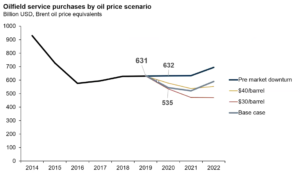Rystad Energy: Shales to be hardest-hit this year as oilfield service market falls by 15%
By Linda Hsieh, Editor & Publisher
The global oilfield service market is expected to decline by 15% in 2020 compared with 2019, Martin Opdal, Consulting Principal, said during a virtual meeting held by the IADC Southeast Asia Chapter on 14 May. This means the firm is projecting approximately $535 billion in oilfield service purchases this year in its base case scenario, compared with $632 billion expected pre-virus outbreak.

This decline comes as most E&P companies have revised their capital budgets down by 20-50% since the beginning of the year, with supermajors typically announcing cuts in the 20% range while regional E&Ps and North American shale-focused companies have announced larger spending cuts. “We expect shale to be the hardest-hit, with a 33% drop in investments from 2019 to 2020, while offshore will be maintained fairly well through this year,” Mr Opdal said.
He also noted that, although in past downturns, companies have preserved spending on brownfield projects, this time the crisis is having negative implications across all life cycles. “You see a lot of exploration programs being cut down. A lot of field developments are either being delayed or canceled altogether. And you also see a lot of maintenance being cut down.”
A few examples he gave were:
- Equinor postponing planned maintenance on five North Sea installations because the virus outbreak is preventing hot bedding, where two shift workers use the same bunk and cabin per 24-hour period but at different times;
- Siccar Point deferring its planned sanction of the Cambo field, located northwest of the Shetland Islands, from Q3 2020 to H2 2021;
- Ithaca not undertaking planned drilling and well intervention on the Alba and Captain field in the North Sea to reduce manning levels;
- EnQuest deciding not to restart production from the currently suspended Heather and Thistle/Deveron fields, also in the North Sea.
On the demand side, Mr Opdal noted that road traffic and aviation likely have both bottomed out and are starting to stabilize. Of the 99 million bbl/day of global oil demand seen in 2019, passenger vehicles accounted for approximately 27% while aviation accounted for 7%.
So far, road traffic is down close to 40% this year compared with 2019. “China’s now actually been recovering a bit, and it’s now back around 18% below what’s normal. But we see other countries that are in earlier stages of the virus outbreak with reductions in road traffic down to 80-90% in some of the most affected countries.” East Asia reached bottom in early March, he said, and demand is now hovering around 20% below normal. “Other regions such as North America and Western Europe, we saw them bottom out in the beginning of April, and they are now about 35% below last year’s levels.”
In aviation, Rystad Energy believes peak reduction of passenger flights reached 60% in Q2.
Overall, the firm believes that global oil demand bottomed out at 71.8 million bbl/day in April and will rebound to 98.9 million bbl/day in 2021. “Overall, we expect demand to gradually come back and be close to what we had expected prior to the COVID-19 outbreak by the end of next year,” Mr Opdal explained.





